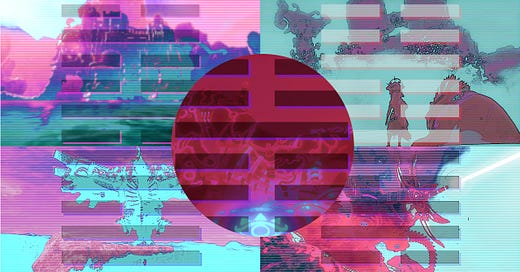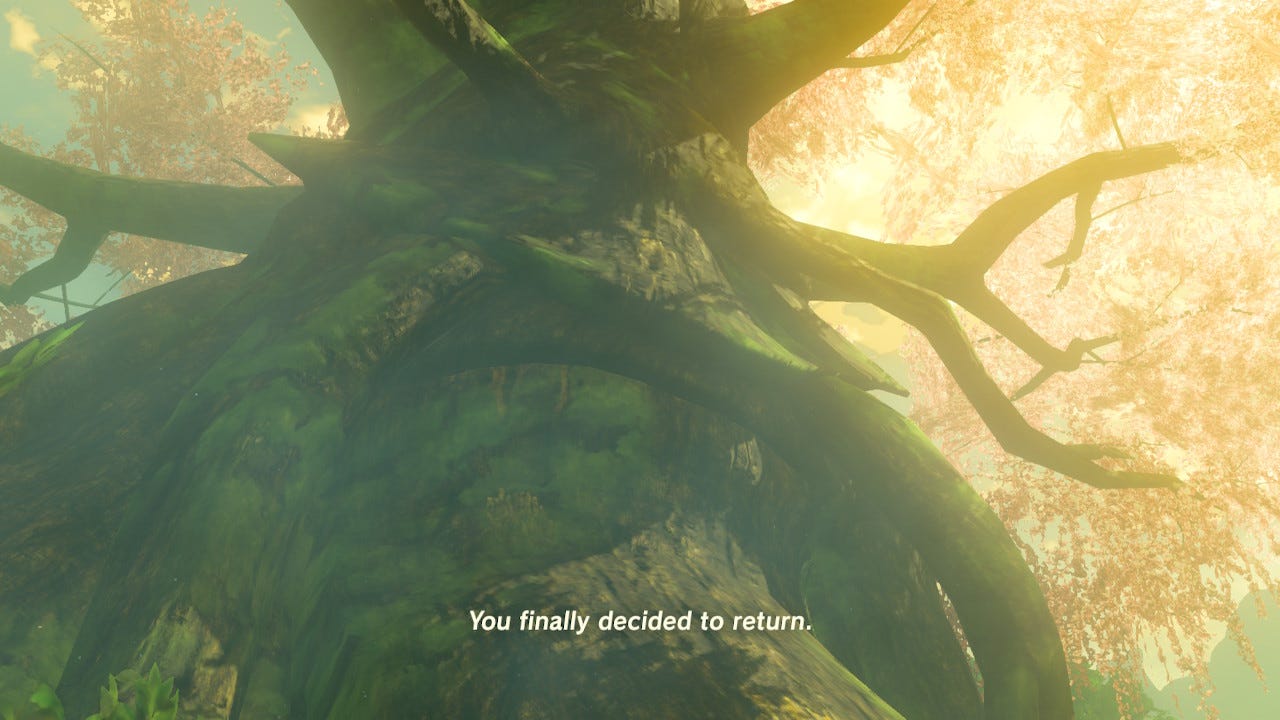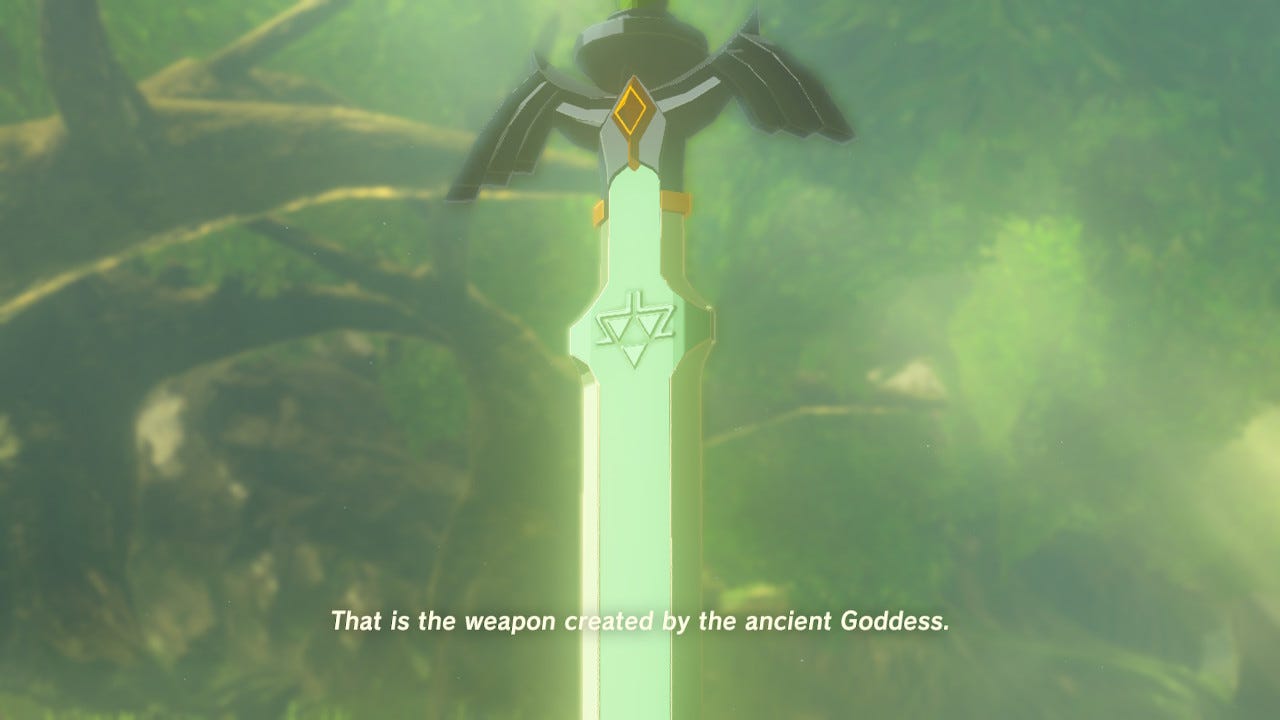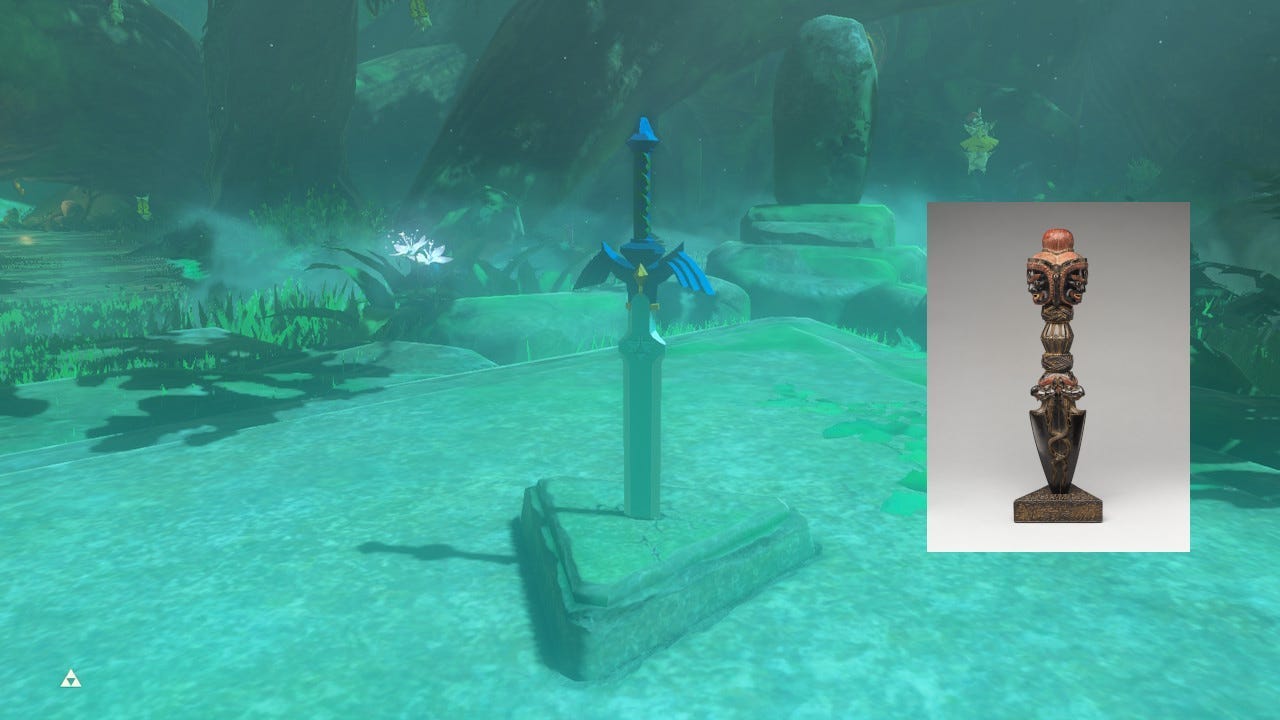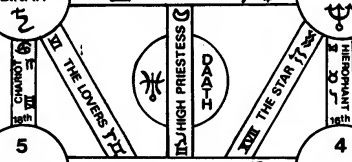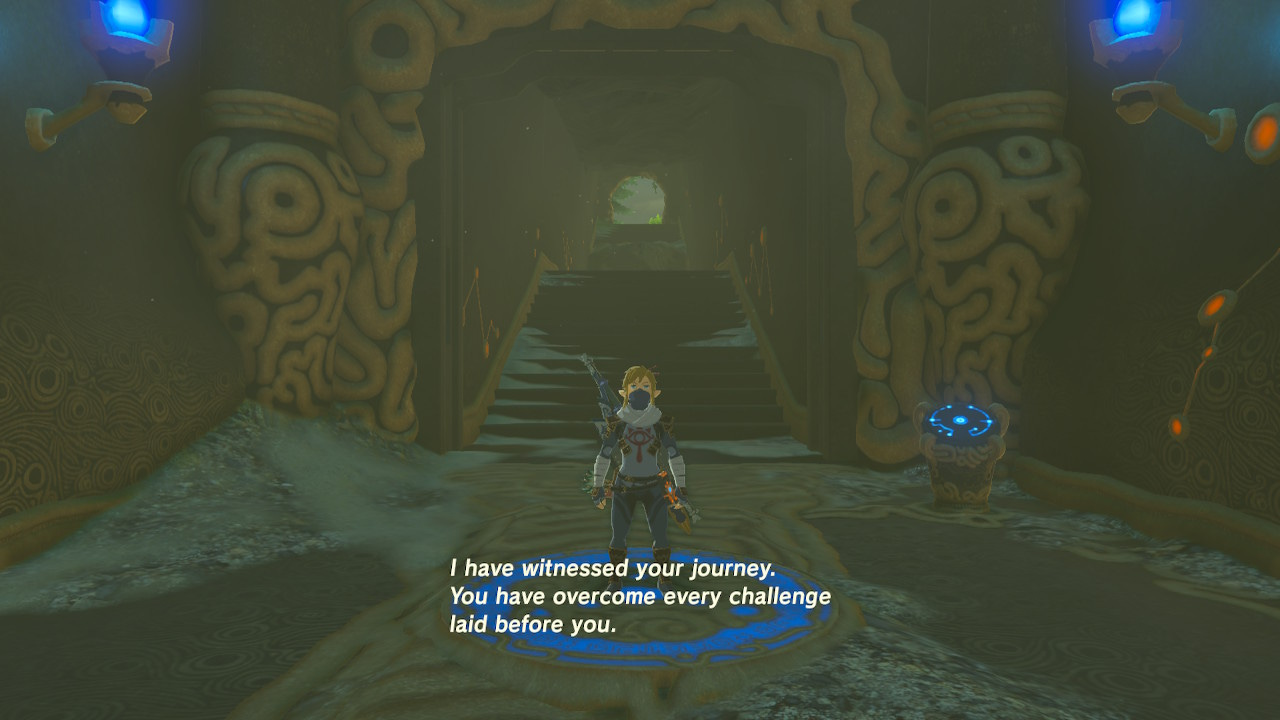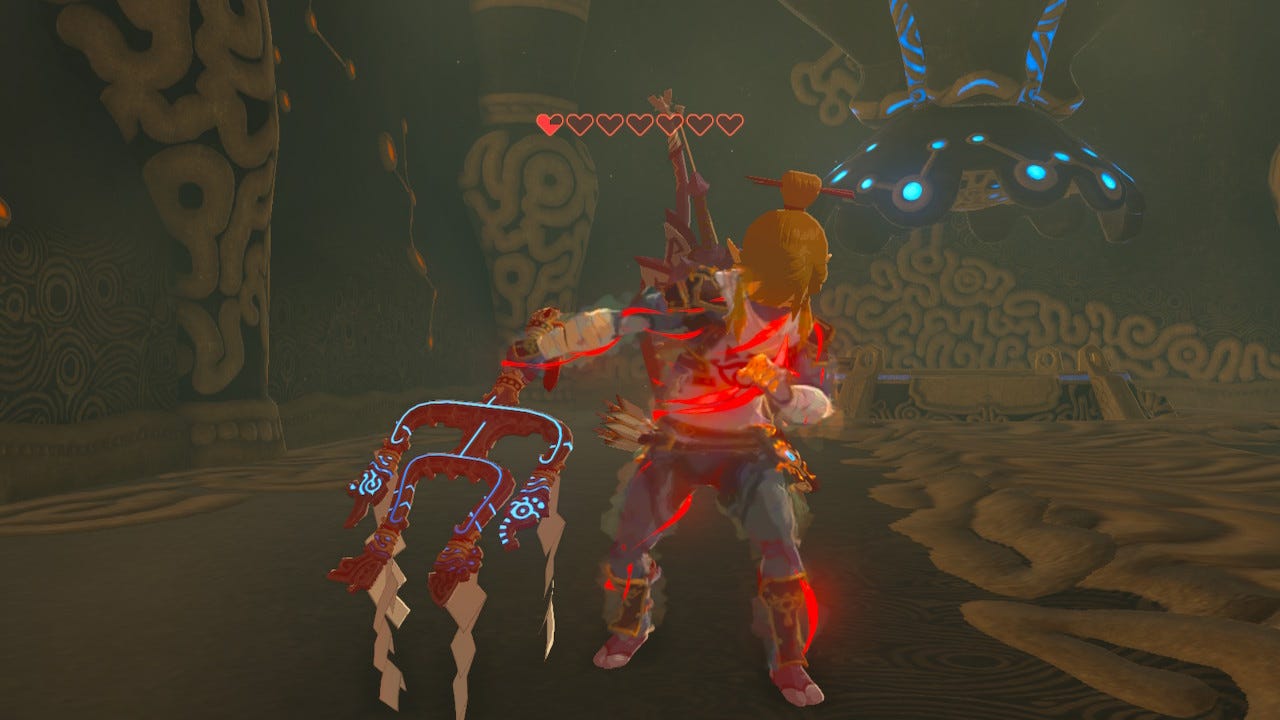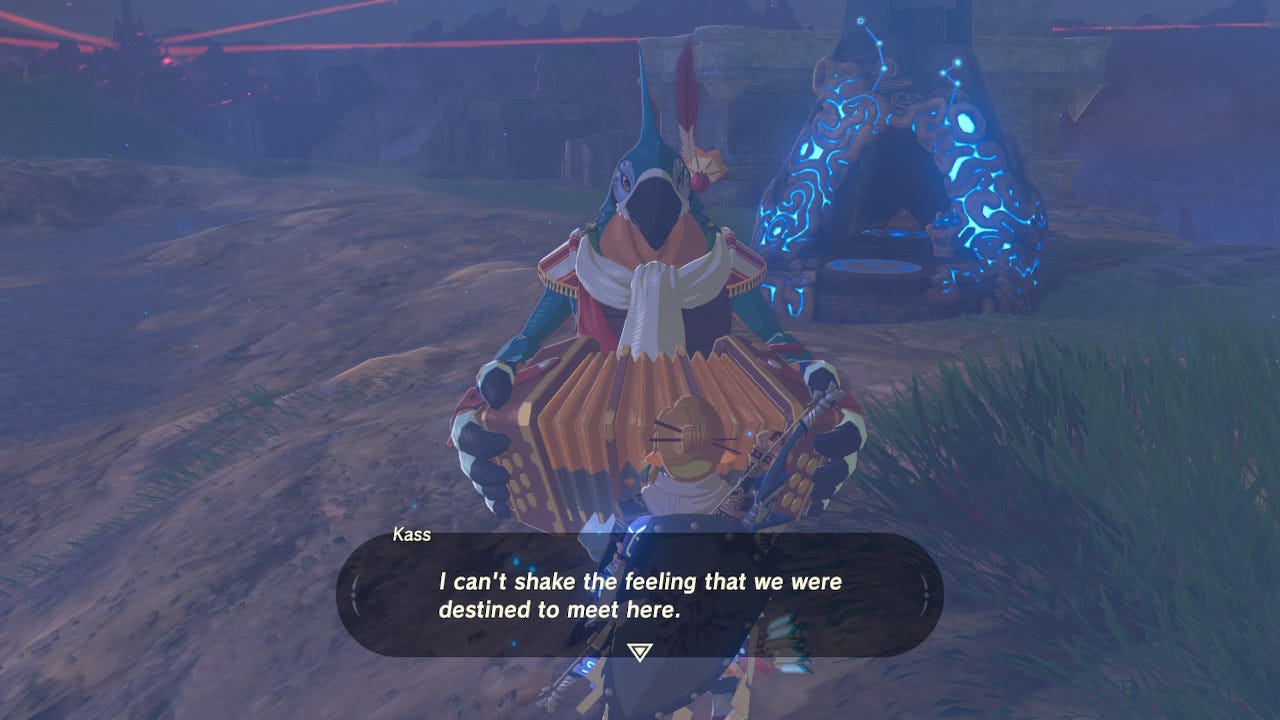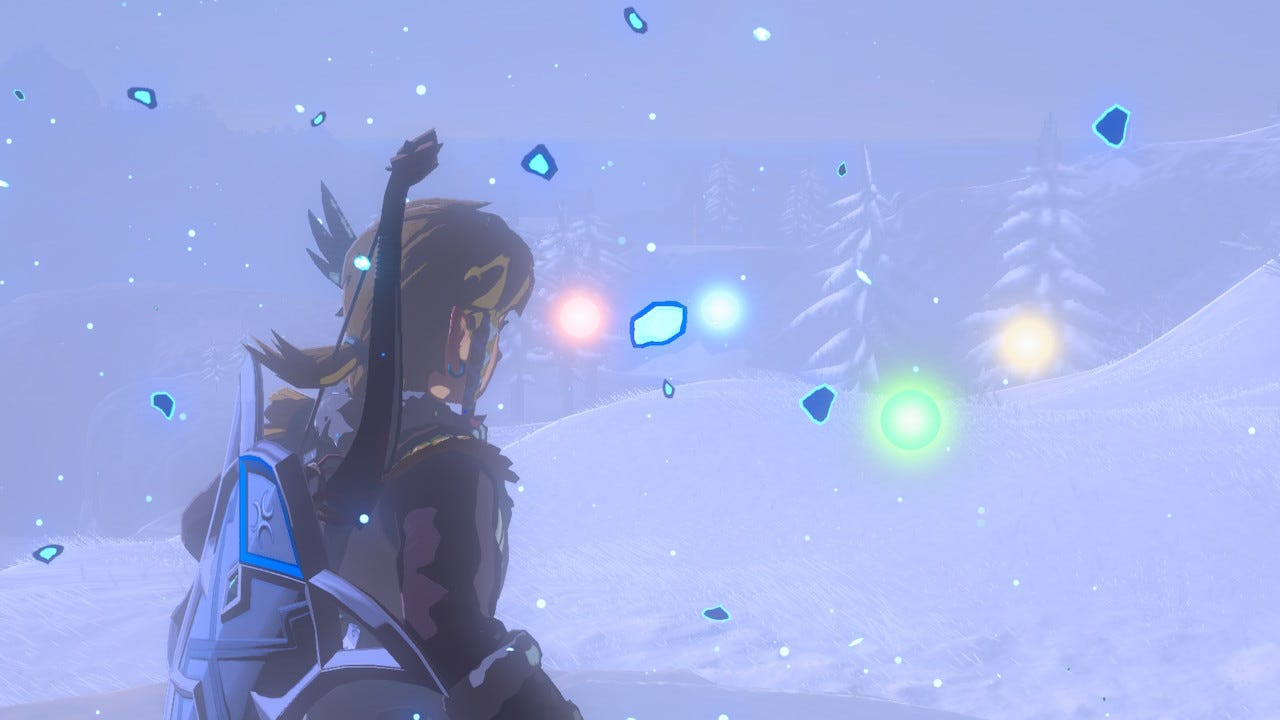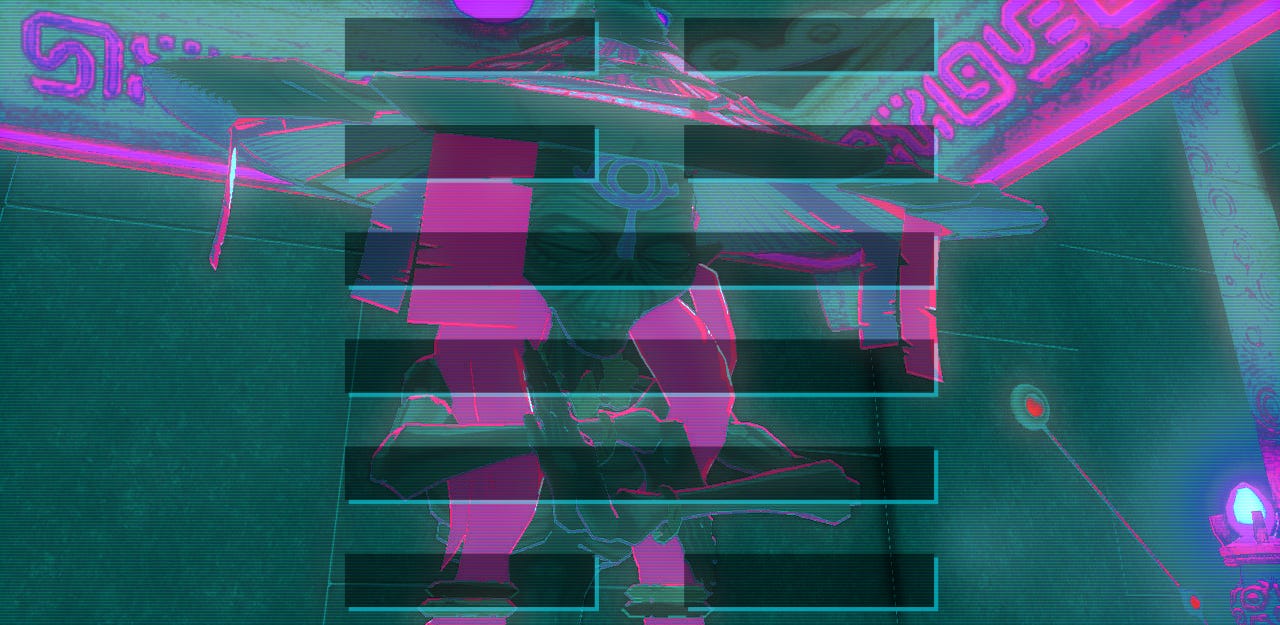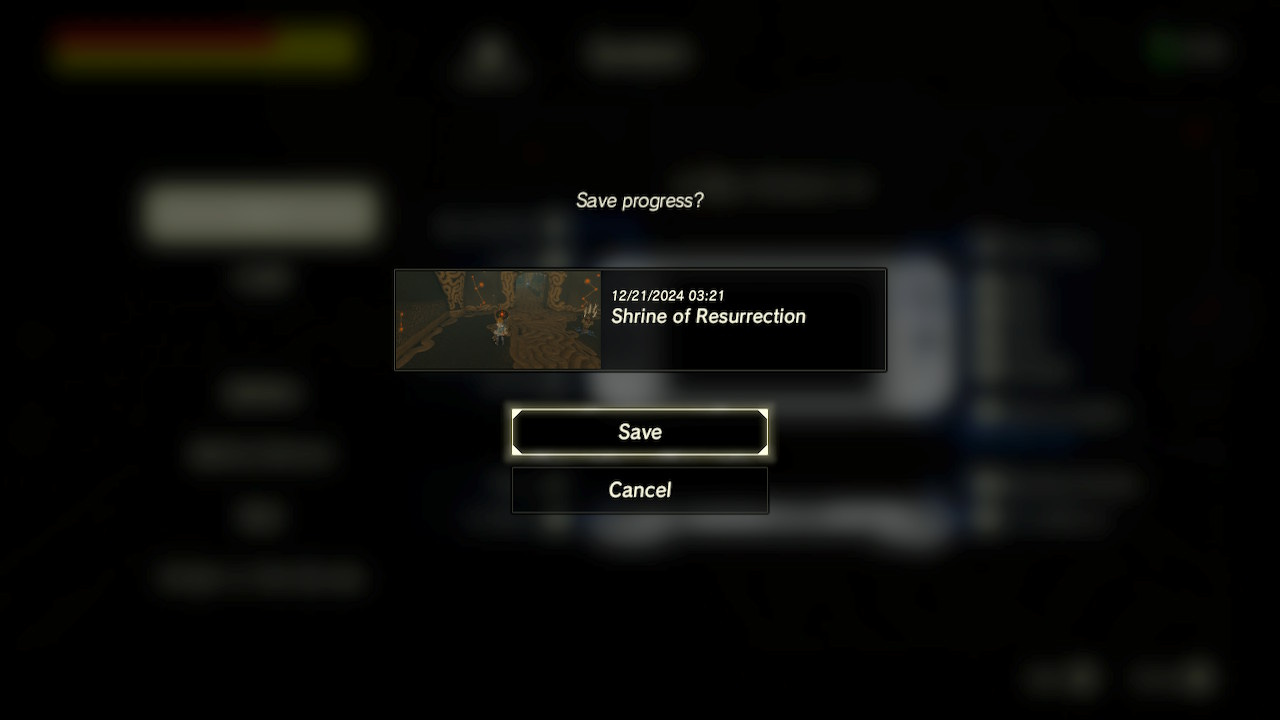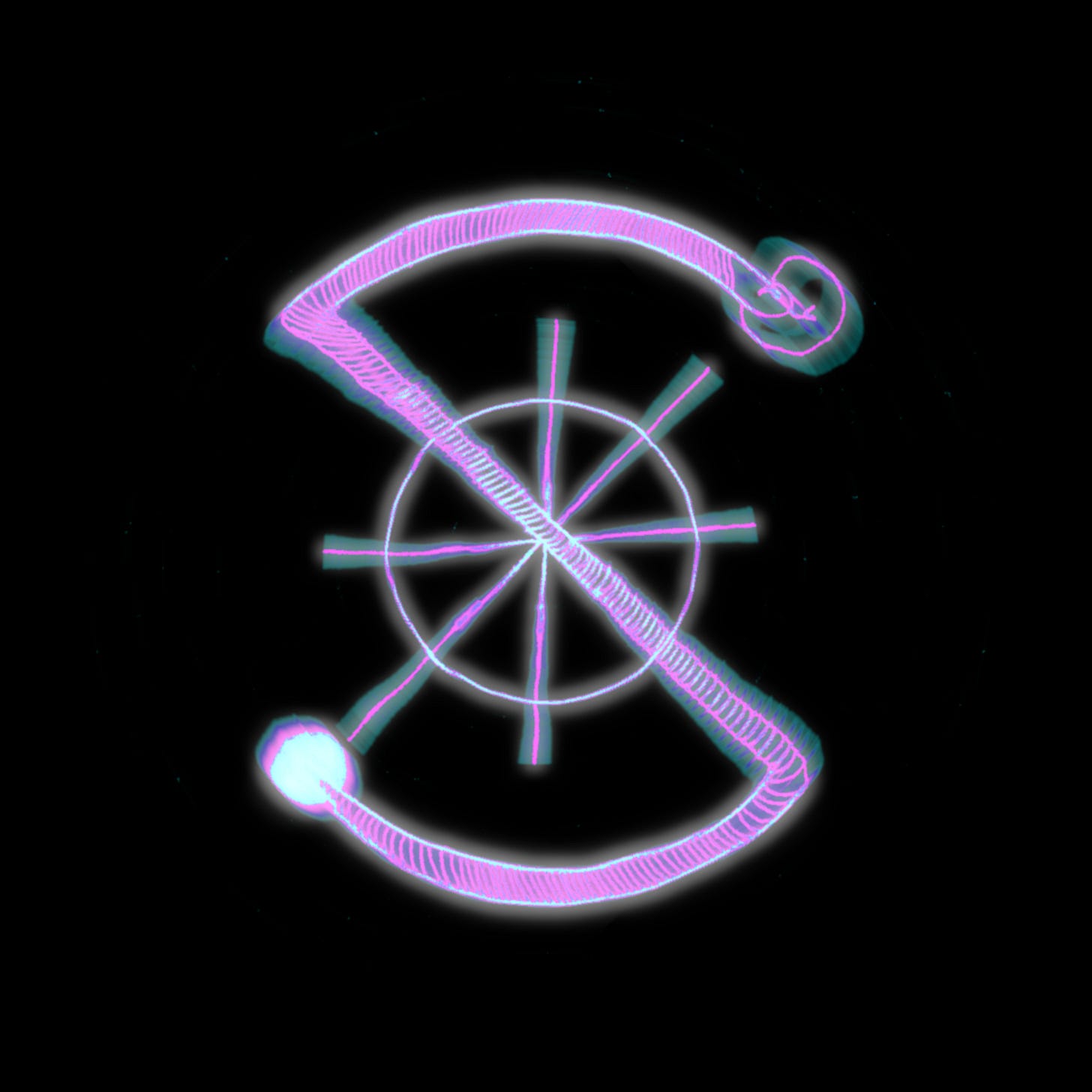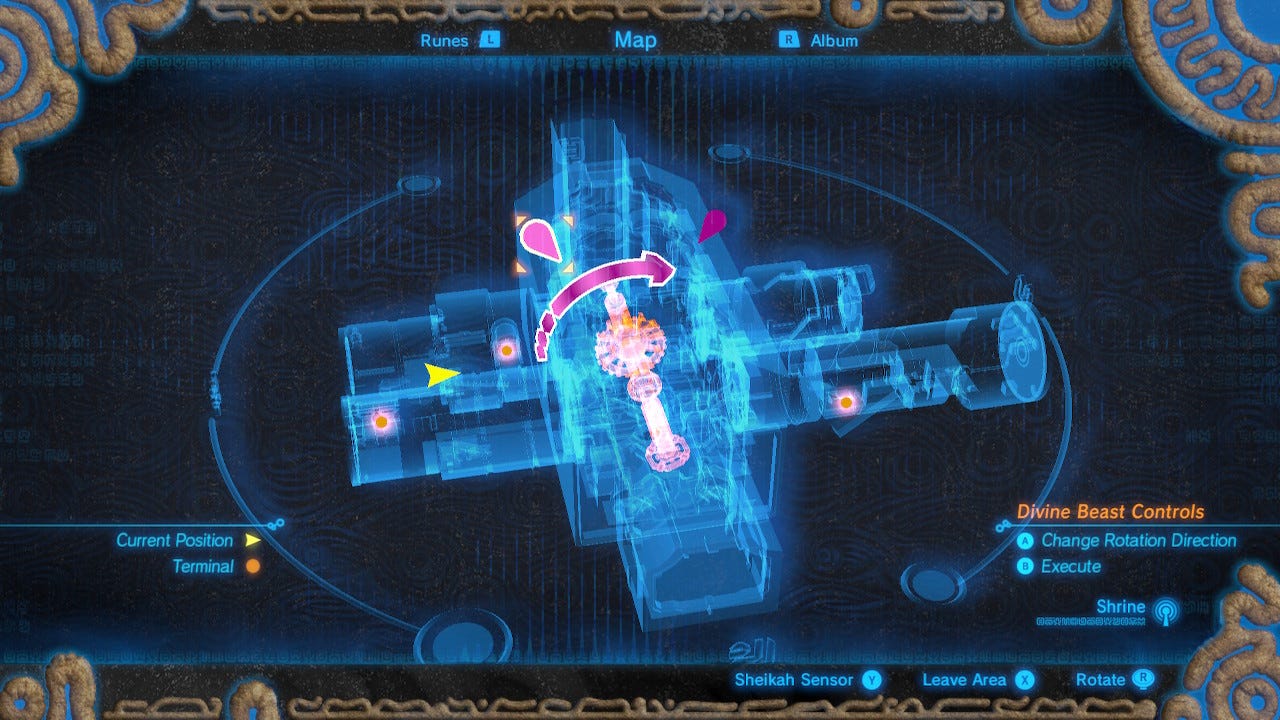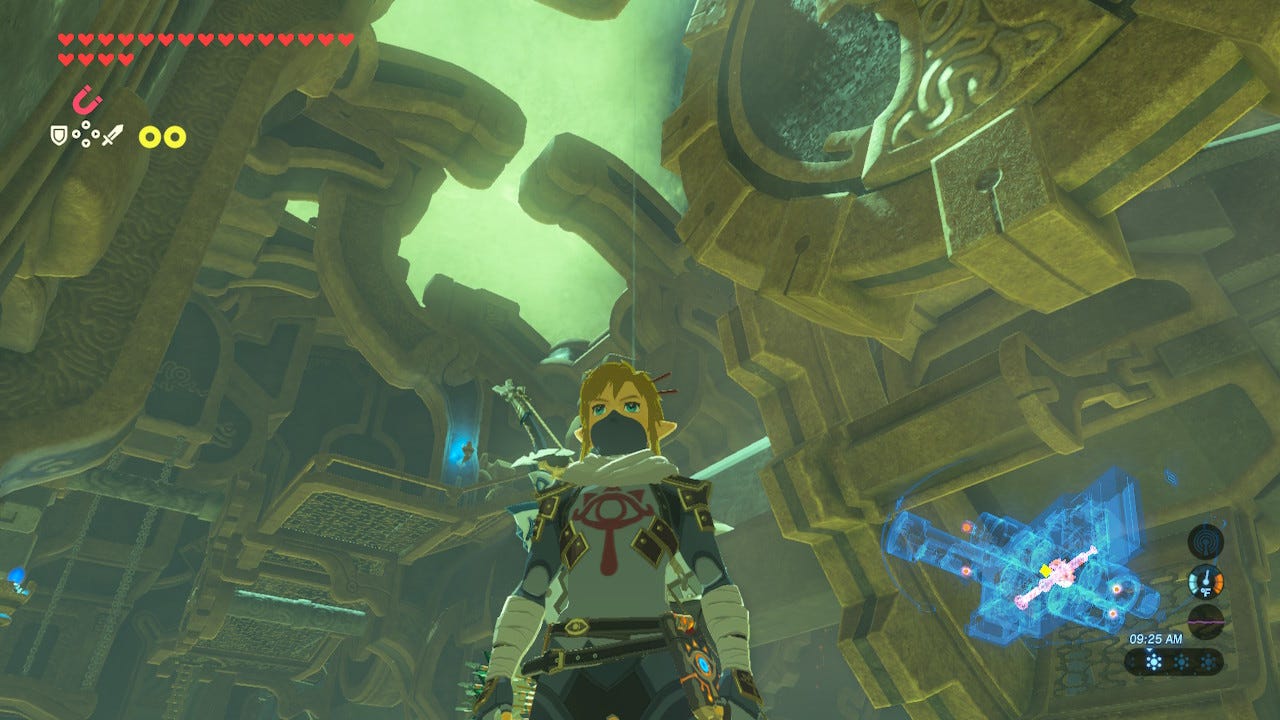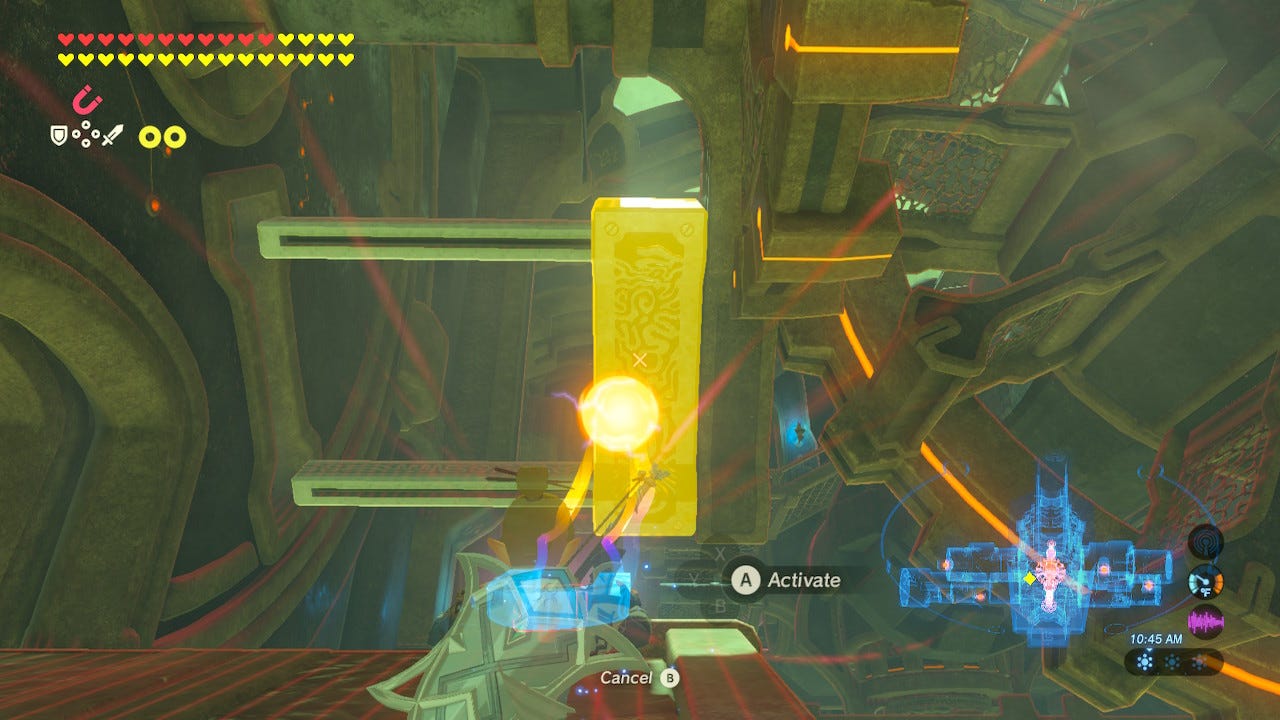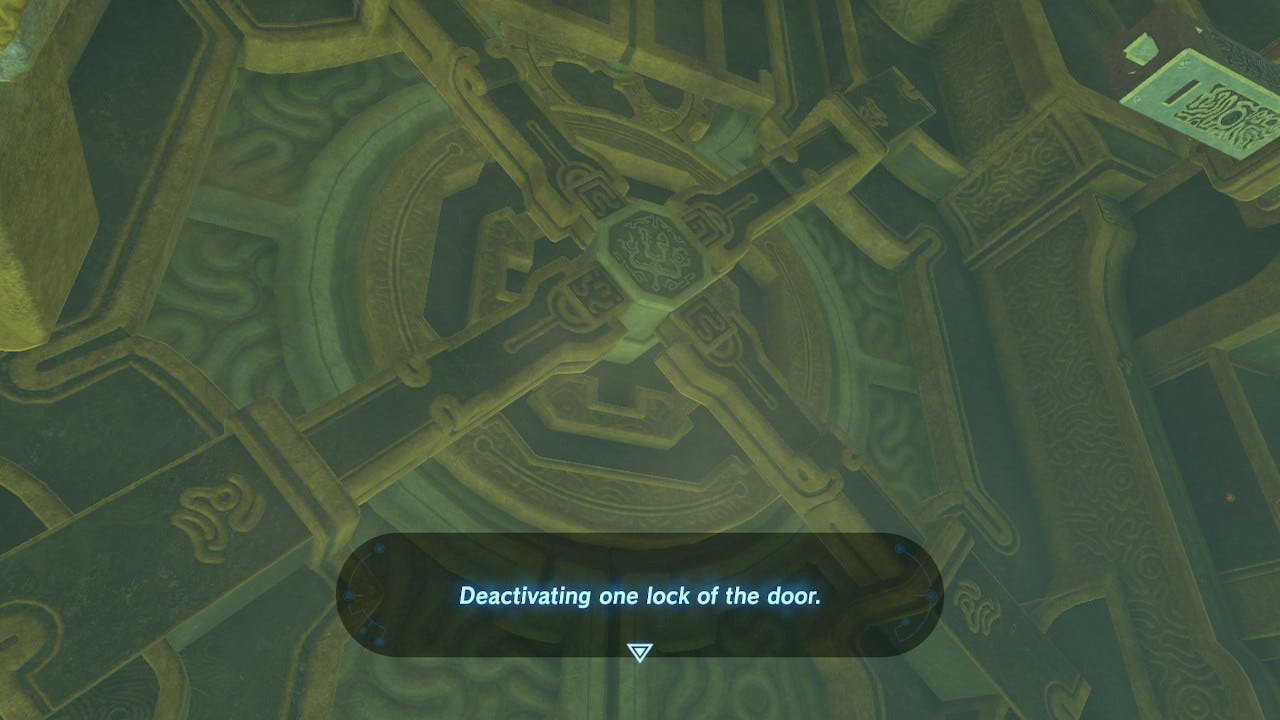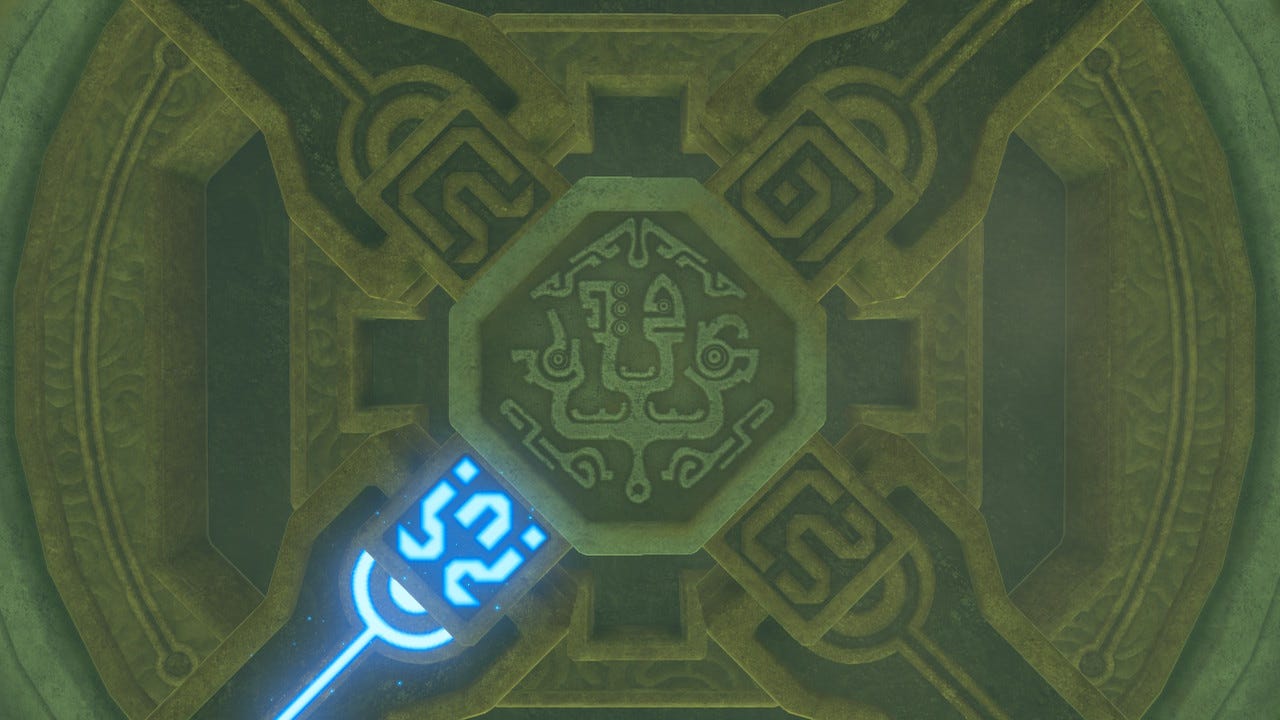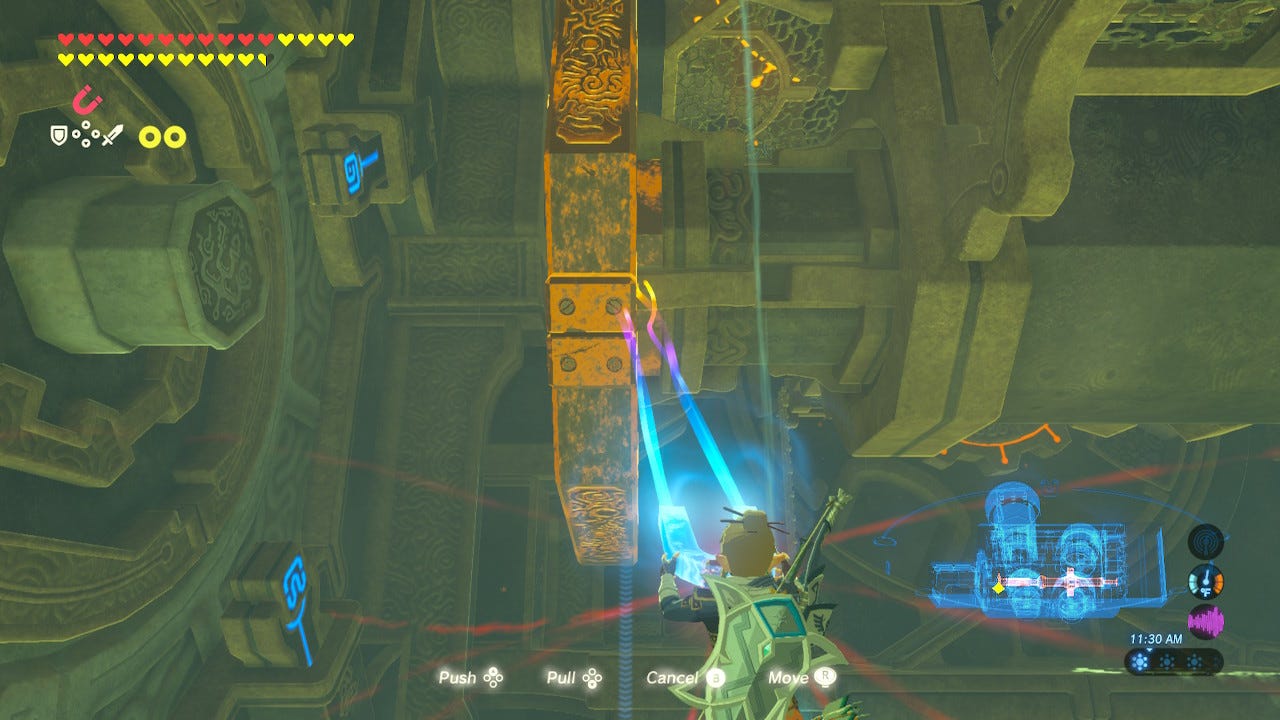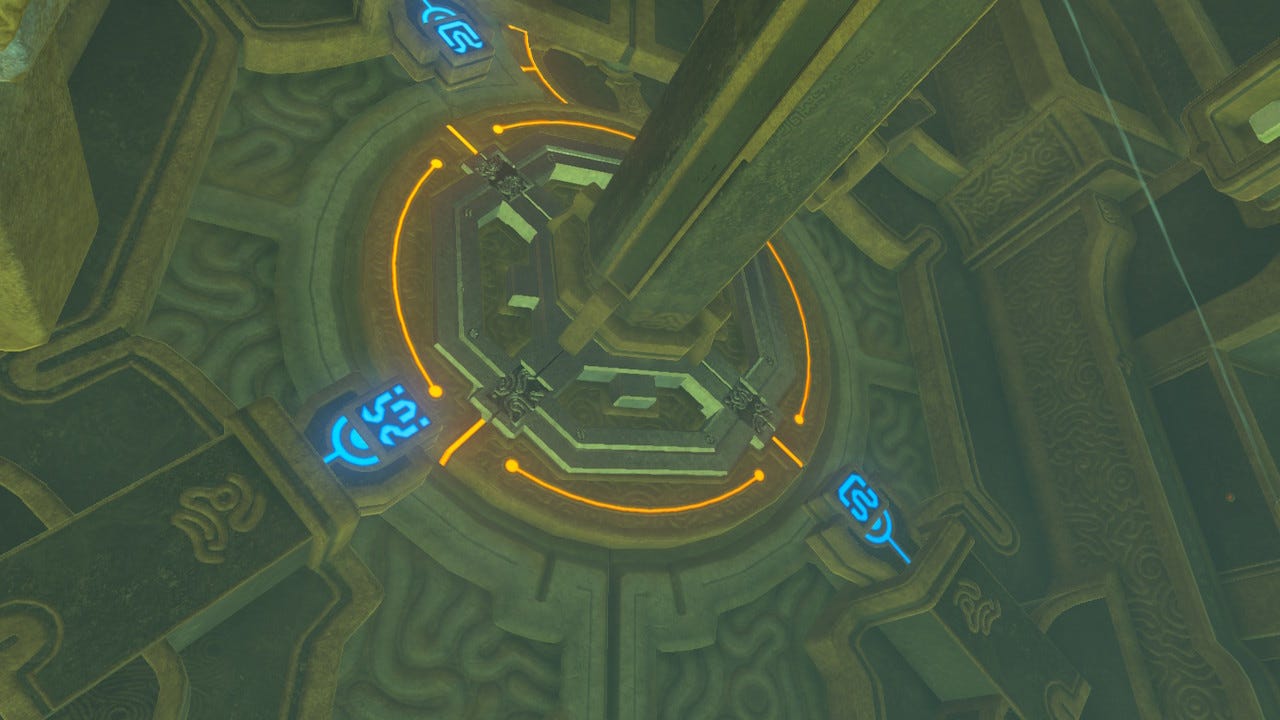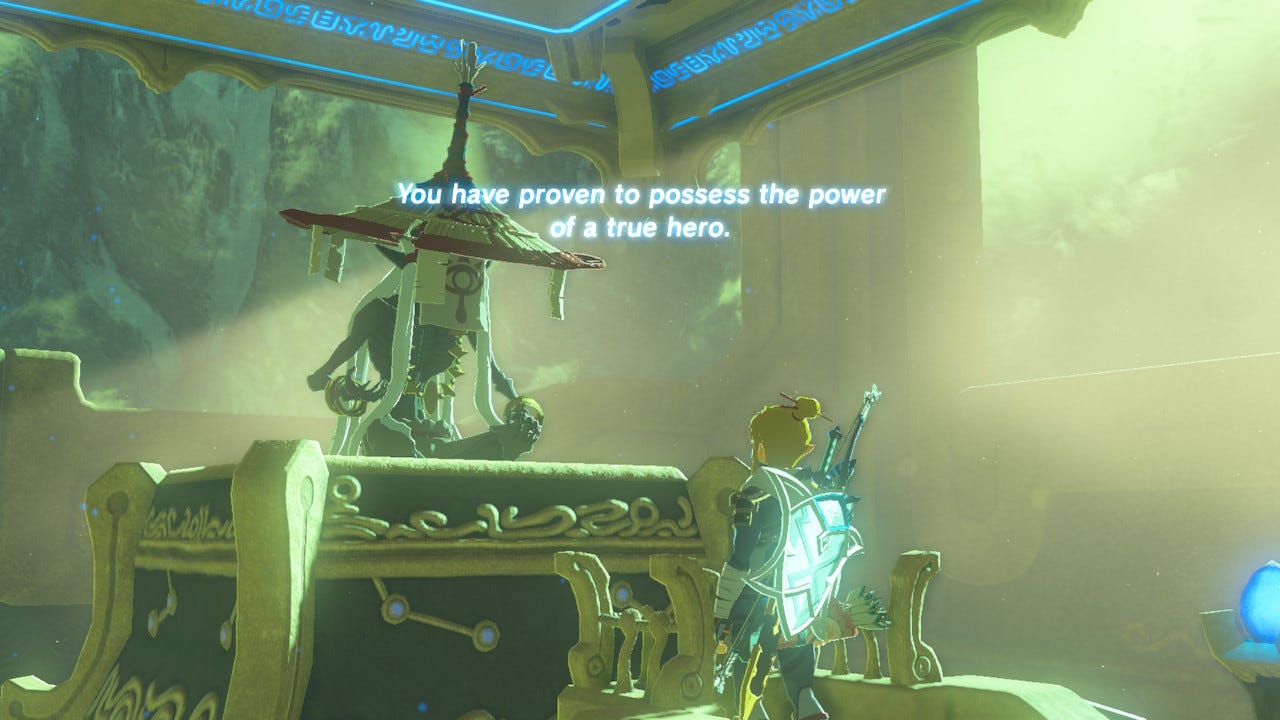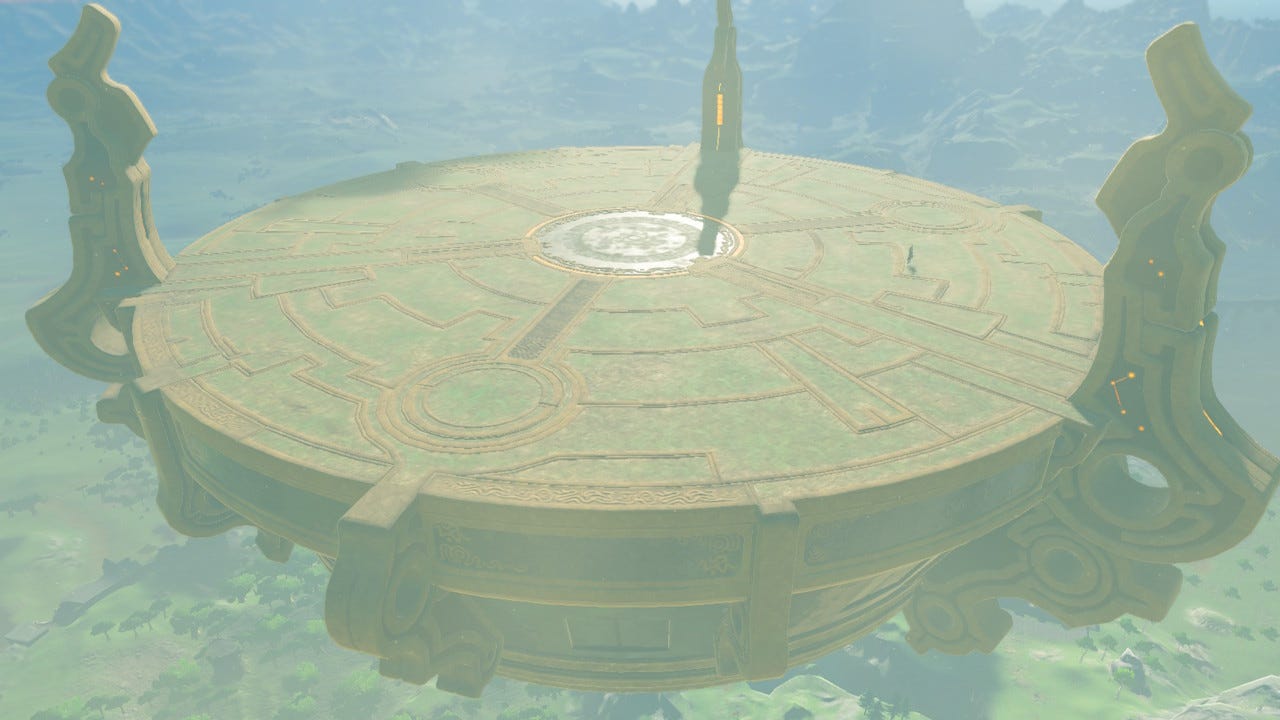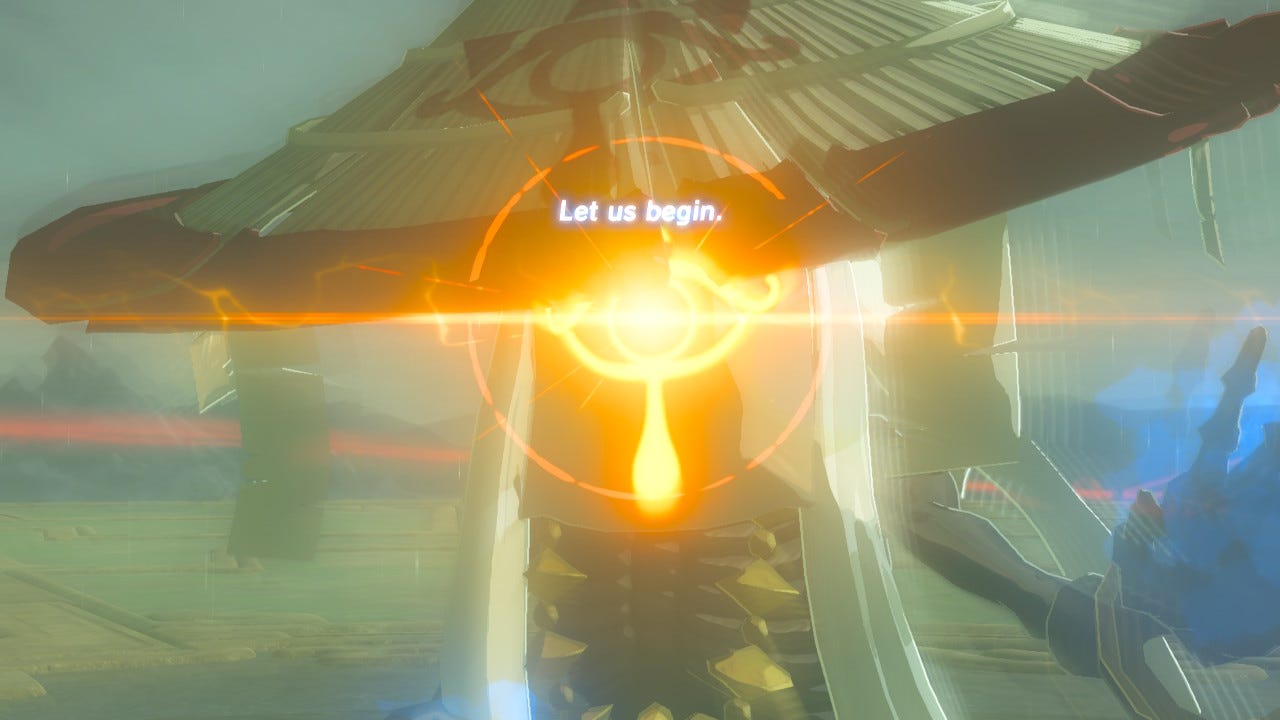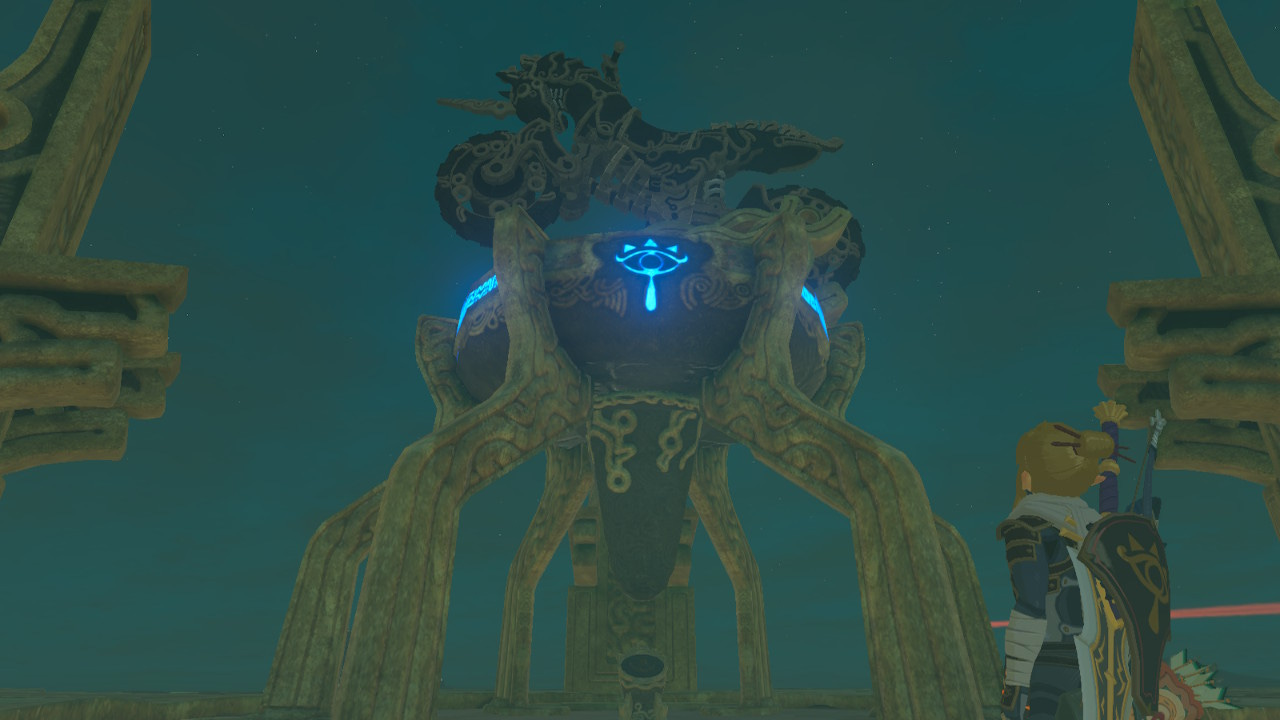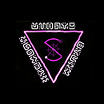Season’s Greetings, my friends—and Happy Festivus to all those who celebrate. I have an early holiday gift for you all!
I don’t actually celebrate Festivus, but I do appreciate it from afar. I remember eating at an Old Country Buffet with my first wife one year on Festivus, and a group of nerdy buddies was celebrating it there in the restaurant. They had a pole and everything.
I like the eminently “immanent” meaning of the holiday: Completely secular, mundane and banal. It’s kind of the “anti-Christmas” in that sense.
After all, we’re only human, right?
In that spirit, I have a correction to make from the previous post. As I wrote, I was all excited because everything sort of worked out on its own so that my 40th Sheikah Shrine was Shorah Hah Shrine, housed inside the “carapace” of a crab-shaped, cave-like rock formation, with a quest called “The Blue Flame.”
As I learned when I went to go trade up some Stamina Wheel segments for Heart Containers so I could pull the Master Sword, my math was off, and based on my original Initiatory playthrough in which I set a rule that I would get the Master Sword and then defeat the four Blight Ganons. However, when you defeat a Blight Ganon, you get a Heart Container, and I had defeated them prior to pulling the sword this time. This meant that I only needed to collect 24 Spirit Orbs from Sheikah Shrines in order to pull the Master Sword.
Looks like I got a little over-enthusiastic; I was off by 16 orbs. It happens.
The Sword That Seals The Darkness
WARNING! SPOILERS for The Legend of Zelda: Breath of the Wild and Tears of the Kingdom beyond this point.
Pulling The Master Sword is a bit of a quest unto itself even once you’re ready. Having the requisite 13 Heart Containers is only the first step; next, Link needs to locate the sword. Where is the Master Sword to be found? In The Korok Forest.
This area of the game is a throwback on a few different levels. The Lost Woods first appeared about 40 years ago in the original The Legend of Zelda for the NES. There, it was simply a section of the world map that was programmed to “trap” Link; once he enters a screen designated as part of The Lost Woods, the only way to escape is to travel from screen to screen by way of the appropriate sequence of directions; if Link attempts to walk to another screen outside of the secret pattern, he will just find himself magically returned to the original screen. It’s like space and time “warp” here.
In the third Zelda game to be released—The Legend of Zelda: A Link to the Past (SNES’ big Zelda outing and still considered the best Zelda game by many people who don’t already give that honor to Ocarina of Time instead), the Master Sword was first introduced. Bearing a striking similarity to the legend of the Sword in the Stone, Link was able to go into the woods in that game and pull the sword from its pedestal after retrieving three magical pendants from three different temples/dungeons.
Ocarina of Time introduced The Great Deku Tree; in that game, Link is raised in a village of little eternal children of the forest called the “Kokiri,” who live under the Great Deku Tree. The Deku Tree is sort of their “tutelary deity,” an ancient and powerful being who guides and protects them.
In Breath of the Wild, all of these elements are synthesized together. The Korok Forest is hidden behind The Lost Woods, which in this game are sort of a “liminal space.” To find his way there, Link must approach the Lost Woods, where there’s a series of torches planted into the ground for Link to follow, and to use to light his own torch.
After he passes the last set of stationary torch “pylons,” he’s on his own to navigate the Lost Woods. If he goes the wrong way for too long, the fog closes in on him, the spirits of the forest cackle, and he is returned to the beginning.
To find his way through, he must hold the torch and watch it to see which way the wind is blowing, following the sparks that trail off of the torch as he walks. It’s a good idea to stop every so often because the direction of the wind changes quickly, but it can be hard to notice while Link is still moving. Once he holds still, the sparks align with the breeze quickly. The turns come very randomly and Link’s path seems purposeless and meandering. Eventually, he finds his way to the Deku Tree and the woods filled with little sprites that look like anthropomorphic tree saplings: The Koroks.
The Deku Tree’s soft pink foliage, reminiscent of cherry blossoms, signal to us that he serves the Goddess Hylia; in Japan, cherry blossom, or “sakura,” is considered a symbol of femininity, and particularly of feminine allure and sexuality. In case there was any doubt, we also learn that the Master Sword itself was created by Hylia (which dovetails perfectly with the way Kenneth Grant explains the symbolism of the sword in Nightside of Eden; and indeed, in some respects, these Korok Woods are highly analogous to the Garden of Eden, are they not? This reflects the connections between the Goddess, the sword represented by the Hebrew letter Zain, and The Lovers card).
Reception of The Master Sword in this version of the game was mixed. Most players (myself included, to be honest) were disappointed. In most Zelda games, The Master Sword has qualities that make it the unequivocal “best sword” in the game. In this game, that can be difficult to see or appreciate. When Link first gets it, it has a damage level of 30, which is pretty good, but certainly not amazing. I’m pretty sure it’s the strongest one-handed sword, but other weapons dwarf its damage output. One exception to this is when the sword is in the presence of any monster or foe that is corrupted by Calamity Ganon (such as the 8-legged, robotic Guardians that patrol the area surrounding Hyrule Castle): Then it glows bluish and does 60 damage per strike, which is the highest damage level in the game for a weapon (though this is matched by the Ancient Battle Axe++).
The one quality that really stands out about the Master Sword (other than the fact that it can fire energy beams when Link’s health is full) is one that carries some more esoteric meaning: Its indestructibility.
All weapons except for the Master Sword take damage and eventually break. This is another thing many players criticized, saying the entire mechanic makes the game too stressful and causes us to hoard weapons more than using them. Still, this is what provides the contrast with the Master Sword. Even in this, however, the sword isn’t wonderful, because it can only do a limited amount of damage before it appears to break; it will remain in Link’s inventory, and he won’t be able to use it until it recharges for 10 minutes.
It seems arbitrary and really detracts from the feeling that this is a “legendary weapon,” but honestly, if the developers hadn’t done things this way, the Master Sword is basically all anyone would ever use, and that would detract somewhat from its specialness, too.
In my ritual instructions for the Hylian Banishing Ritual (HBR), I note that I use a phurba instead of a dagger in my practice, and in ‘Til Daath Do Us Part, I included a couple of screenshots with embedded photos of real-life phurbas to show that I am almost positive it was the intent of the developers of the game to incorporate phurba-related symbolism. Frankly, I could write an entire post about all of the overlap in symbolism between the Master Sword, the phurba, and the bigger picture of what’s going on in the game. In fact, I think I will do that.
However, one aspect of the phurba connects the Master Sword with the symbolism of the reward from Bareeda Naag Shrine: The Diamond. A phurba is another form of the vajra/dorje, or “Diamond Thunderbolt.” It is often referred to as an “adamantine" dagger in Tibetan Buddhist traditions that have absorbed the phurba into their practices from other cultural sources, and that same word is used to describe the Master Sword at least once in Breath of the Wild. I have studied phurbas on and off for over 15 years and I am telling you, the notion that the developers fully meant for the Master Sword to represent something like the phurba is very hard for me to dismiss.
Of course, apart from its evil-repelling (and vanquishing) purposes, the Master Sword has another symbolic meaning at this point in these writings: Now that the Divine Beasts have been freed and I have offered esoteric commentary on how they represent the formation of individuals from the vast sea of undifferentiated consciousness, the last step is to initiate the actual “descent” from this other-realm into the physical world; for it to “incarnate.” To be born into the world, like Set, means using the Master Sword to rend the veil between the Abyss and the manifest universe.
As I have discovered, the HBR is an “inverted” banishing ritual wherein metaphysically, it is taking place almost entirely in the Abyss. While traditional banishing rituals employ the upright pentagram or pentacle, I work instead with inverted pentagrams (or triangles, as in the case of the HBR). For upright pentagrams, the four lower points represent the four elements while the uppermost point represents “spirit,” “akasha,” “aether,” “the quintessence,” etc. In the HBR, the four elements represent aspects of the Self, and the fifth point is the only one that juts down into the physical realm. It represents your material self.
As such, the path it follows into manifestation is the same as the one across the Abyss—only in reverse. I’ll now veer into a discussion of theory, as usual. While the esoteric aspect of this journey is expressed in the journey back across the Abyss, the same journey in-game is symbolized by Link’s return to the Great Plateau—where it all began.
In a sense, the Great Plateau and the Korok Forest reflect one another in the same way that Tiphareth and Daath reflect one another.
In fact, for those who have plenty of extra time, here is a comprehensive theory video from NintendoBlackCrisis which illustrates some intriguing connections between those two zones in the game:
Dogma
The purpose of this section is to weave a solid set of connections between the following:
The 5 paths that cross the Abyss
The upcoming Vatican ceremony—beginning tomorrow—to open 5 doors in inauguration of the Catholic Church’s 2025 Jubilee Year
The HBR as a whole
The 5 doors within the Shrine of the 5th Divine Beast
As I wrote in the previous post, the entire inclusion of “paths” across the Abyss is a bit misleading, because crossing the Abyss will necessarily involve going through processes or reckoning with concepts (in this zone, the two are not clearly separate concerns) that are altogether expressed by all five paths. The transformation in question is simply so transcendent and significant in scope that no single way of looking at it or understanding it will ever suffice to capture it all.
In fact, it’s probably not possible to fully exhaust different ways of expressing it because realistically, the very nature of this “place” is that it defies all analysis and rational comprehension. To me, this raises the question: Is there even really “such a thing” as the paths in the Abyss? How real are they? Real enough that if someone were to undergo this experience without having ever studied Qabbalah or tarot—would that person come up with something at all similar to describe what they’d been through?
I tend to doubt that.
I think it’s very likely that a lot of what’s going on with these “5 paths” is that the Abyss reconciles everything—all opposites—and since we had been working with such mental constructs as light/darkness, masculine/feminine, the four elements, etc. below the Abyss that once we actually get there, the paths aren’t “real,” but are instead projections into the Abyss made by us because we take their related concept so deeply for granted.
Then again, some of the experiences I had while I was crossing the Abyss seemed to suggest that a lot of this symbolism is more or less objectively real. That is, without having been primed for it first by most of the literature that many Thelemites read before trying to cross the Abyss themselves, I nonetheless saw a lot of the same symbolism and came to a lot of the same conclusions on my own. It was notable to me because at the time it happened, I wasn’t really doing solid ceremonial magic(k) work. I had spent a few years exploring neopaganism instead. I was sort of getting a breath of fresh air from the Golden Dawn and B.O.T.A. study I’d done for so long, learning about what other people do in their practices, other ways of exploring magic(k)al work, etc. I had worked mainly with Hekate, whom I really did not associate with ceremonial magic(k) at all.
And yet, once I got there, all I saw was eyeball symbolism, dog symbolism, beast symbolism, grail symbolism, the whole works. It all impressed me so deeply that frankly, in my years of previous study, I hadn’t actually come to comprehend the deeper meaning of a lot of those symbols, despite having read about them more than once. The meanings didn’t sink in until I experienced them.
How can you be “prompted” by texts you study to have experiences you never comprehended before having them? How can that work unless there really is something fairly “real” and enduring about these symbols, outside out own heads?
I really came to the conclusion, at the end of it all, that a whole lot of stuff in the world of the occult is meant a lot more literally than we tend to believe before we actually experience it for ourselves.
Yet, I still can’t say with full confidence that I would have had all of those same experiences if I hadn’t studied it all first, even if much of that study had been long ago and was no longer “top-of-mind.” After all, even the texts that refer to the Night Side of the Tree by way of its tunnels and its qlippoth also say that this realm can essentially be summed up as the subconscious mind. There are all these attributions that we use, but at the end of the day, most of our esoteric work ultimately boils down to all of the myriad ways that our conscious and subconscious minds intermingle and play together. Or war with one another, for the unfortunate.
Again, I say: Maybe the tunnels and the qlippoth are only as “real” to us as we once rendered the paths and the sephiroth?
If I never laid eyes on a Tree of Life, maybe I could still encounter the Abyss—but the symbols I saw there would be drawn from somewhere else in my lived experience? Maybe they wouldn’t have 10 stages. Maybe they wouldn’t care that most of the world counts 12 constellations, 7 classical planets, etc.
Maybe everything we encounter there is, in short, none other than the “Symbol-Logical Fuzzy Relation” described in High Magic by Frater U∴D∴?
By the way: I think that if I ever lay claim to a fixed answer to any of these questions, I’ll be getting ready to die soon after, because I don’t think fixed concepts are very helpful in this spiritual territory.
But it’s interesting to think about.
I return to the film Dogma, which I briefly mentioned in the previous post. I watched it again this week in preparation for this post. To review, the basic plot of the film is that two fallen angels—Loki and Bartleby, played by Matt Damon and Ben Affleck, respectively—receive word that a Basilica in New Jersey is holding a Plenary Indulgence ceremony of its own, celebrating a Jubilee year, etc. As Bartleby explains to Loki in the opening scene, the deal is that whoever walks through the doorway of that church during the specified window of time would be cleansed of sin. For two fallen angels to be cleansed of sin would cause a paradox:
Due to the doctrine of Papal infallibility—which holds that the Pope is infallible, and that whatever the Pope holds true with regard to the Catholic Church on earth, God would hold true in heaven—a loophole is set up here that threatens all of existence. Since God was the one who condemned Bartleby and Loki, the Papal decree overrides God’s very Will, resulting in the blinking out of existence because that math just don’t math.
What does that sound like?
It kind of sounds like a Catholic way of saying, “As above, so below.”
It also kind of sounds like a situation where there are tunnels and qlippoth on the dark side of the Tree of Life because there are paths and sephiroth on the front—no more and no less—and that for people who are never exposed to the Tree, there’s something else entirely to be found in the darkness of what we refer to as “the Abyss.”
It kind of sounds like the subconscious mind applies the Symbol-Logical Fuzzy Relation to the sheer darkness it contains in order to generate negative images there.
Grant seemed to hint at something similar in Nightside of Eden when he wrote that the tunnels and qlippoth are less distinct or defined than their counterparts on the front of the Tree—for example, that in the spaces between one path and another path, there are smaller offshoots of the main paths, and offshoots of those, and offshoots of those, so that there are no actual “gaps” back there; even between the tunnels and qlippoth, there’s a sense in which it’s still all “melted” together, molded superficially from the unbroken, infinite void in a “spiderweb” pattern.
The whole thing is a phantasm.
However, regardless of the specific details, the phantasm we happen to see there is the one we must reckon with; and when I examine the big picture here, all I can say is that these 5 paths across the Abyss are “real enough.” They seem to have very palpably shaped vivid, deep experiences of mine.
To review, these are the 5 paths in question:
Before I even begin parsing all of this, there are a couple of important details to get out of the way: The infamous changes to these attributions that were introduced by Aleister Crowley. Aside from bringing clarity to some of the details we’ll be engaging with as we proceed, another good reason to bring this all up is because of a deeper truth that it expresses.
First, there is the order of the tarot trumps and their Hebrew letter attributions:
To reiterate, there are 10 sephiroth and 22 paths on the Qabbalistic Tree of Life, and there happen to also be 22 Major Arcana tarot trumps, and 22 letters in the Hebrew alphabet.
The set of attributions illustrated above reflects those authorized by Aleister Crowley in Liber 777, but it’s important to note that there is a change from those attributions to the ones used by the Hermetic Order of the Golden Dawn. The changes in question are kind of a big deal. I am not very qualified to explain them, and this stuff is so complex that even the article to which I am about to refer you says that its author is also not qualified to answer the question, though the explanation looks very good to me. You can read about the details at The He/Tzaddi Switch.
In short, however, the above chart shows Path 15 as The Star, with the Hebrew letter attribution of Heh. This was changed from The Emperor (but the Hebrew letter attribution was still Heh—so only the card was changed).
The article I linked to above explains some of the deeper reasons for the change—a “correction” which was itself made necessary by a previous “correction.” However, I can help even a relatively inexperienced reader see what’s going on here: Look at the other four paths around The Star. You have the Hierophant and High Priestess flanking it—both part of the early series of cards that each show a central human figure. The original attribution—the Emperor—was one of them, and he fit in perfectly on the path immediately following that of The Empress, his consort. It would make sense for them to go together, right?
Well, with this switch, the Emperor now appears way down at the bottom of the Tree of Life, in the middle of a run of cards that otherwise emphasize celestial bodies: The Sun, The Moon, and then The Star. Instead, it now goes The Sun, The Moon, The Emperor.
Womp womp. That feels weird, doesn’t it?
There’s an additional reason this feels “off” to me. There are 5 paths, right? Right.
And how many elements are there? The four main elements, plus spirit—5.
I took a look at elemental attributions, and they are as follows:
Hierophant: Earth
Chariot: Water
Lovers : Air
Star: Air
High Priestess: -
However, the Emperor is which element? Fire. So here, we have two cards with the element of Air, and Fire is missing.
Well, yuck.
At this superficial level, one realizes this seems strange and doesn’t appear to add up. See, the thing about these attributions is that there’s a reason we’re even organizing all of this information to begin with: To help us make sense of the world and ourselves, and to establish a symbol system that helps us do the same. For that to work, the meanings should certainly make some rational sense.
However, we also apply aesthetic standards as one other aspect of verifying this. We look for elegance and things like symmetry, because that’s part of the core teaching here: That the world exists purposefully, that there is a divine order behind it all and that it all happens the way it does for good reasons.
As you familiarize yourself with the details of the changes made over time, something becomes apparent: Somewhere along the line, established meanings that made sense at one point ceased doing so. Each change brought further aesthetic harmony in one sense, addressing one problem—only to give rise to another. Then that problem was addressed, producing yet another still.
Was there ever a time when these meanings all seemed to line up in a truly perfect harmony? Is the set of attributions we’re using now a “corrupted” set of keys?
I don’t know. To suppose such a thing is to make some pretty bold assertions about the fundamental nature of reality; to say there is a “correct” way for all of this to fit together is to unequivocally affirm the existence of something like a God who actually cares about that stuff. If you already hold such beliefs, this is just adding some stimulating beauty to them. If you don’t, it’s doubtful such apparent symmetry will sway your opinion if you’re not already disposed to belief.
For my own part, I don’t need there ever to have been a “perfect” set of keys. To me, these wonky attributions reflect something very similar to another aspect of the “problem” of doubling up the elements of Earth and Fire in the HBR; Plato recognized it:
In short, there’s no such thing as a perfect circle.
The world above the Abyss can be perfect because the world below it cannot.
That imperfection is simply a part of the beauty of life.
I take this at face value and release the desire to influence the attributions any further so as to try to “fix” something. I do my best to live by the Word of Xeper; I’m not looking to tie everything down. Let it keep evolving!
All of that said, let’s take a look at some of the results of holding to Crowley’s attribution of The Star to Path 15.
Firstly, there is the comment from Crowley in The Book of Thoth:
It is especially to be observed that the three consecutive letters, Gimel, Daleth, He' (Atu II, III, XVII) show the Feminine Symbol (Yin) in three forms composing a Triune Goddess.
p. 76
This rather keenly serves to tie the traversal of these particular paths with the same Triune Goddess symbolism that is reflected in Hyrule via the three dragons or the three aspects of the Triforce. In the Ocarina of Time and other subsequent Zelda games, there are three goddesses who line up here: Din, Farore, and Nayru. Those goddesses do not appear in Breath of the Wild, but the dragons do.
Beyond these three “paths of the Triune Goddess,” those two that remain just happen to be Paths 17 and 18—the Chariot and the Lovers—the two paths in particular that I have identified as being associated with the Word of Hermekate.
That, uh…looks pretty symmetrical to me.
The two of them are also gender-neutral (or rather, gender-inclusive). Traditionally, that is; for a more progressive perspective (both culturally and spiritually), the article Moving Beyond Gender Binaries by Dr. Peter Duchemin helps us cut through some of the constricted thinking that can arise here. Notably, he also makes reference to a tarot deck based on pure color expression, which seems to support my speculation above regarding “the other side of the Tree” and the openness of the Symbol-Logical Fuzzy Relation: In other words, that what we see in the Abyss is absolutely conditioned primarily by our own deepest-held frames of reference no matter what those may be.
So keep that in mind, then, that these paths very likely only appear in the Abyss if we have carried them in with us.
However, once established there as patterns, they are very much then reflected back again upon reality itself:
The theme of the Jubilee this year is “Pilgrims of Hope.” “Pilgrim” could refer to pretty much anyone on any spiritual journey, but especially this one across the Abyss. In addition, one of the main key words attributed to the Star card is “hope.” Divinatorily, when this card appears in a tarot reading, a direct interpretation is often that the querent will receive their dearest wish.
Let’s see how all of this is reflected in Link’s journey.
You Make A Ballad Point
Yes; unfortunately, Breath of the Wild is one of those games that has rolled out the DLC schtik, where you don’t really get the whole game upon buying the main game. I am not thrilled about it and sometimes I have felt like the optics of spending so much energy fleshing out the esoteric meaning of a game that relatively few people will ever get to play are a bit tone-deaf; but then I remember I’m not responsible for that. All I can do is my best with the tools I have in front of me. I can’t see all of this stuff right before my very eyes and not say something.
That being said: With The Champion’s Ballad DLC installed, completion of the quest “Free the Divine Beasts” will trigger Zelda to telepathically contact Link the next time he teleports somewhere. She tells him to go to the Shrine of Resurrection and place the Sheikah Slate back on the pedestal where he got it. Since I know how to trigger the quest, I usually warp straight to the Shrine of Resurrection so that I’m already standing there when I get the invitation.
Upon returning the Sheikah Slate to its source, a new pedestal appears, with some kind of “forked instrument.” It looks kind of like a trident, but with four tines instead of three.
This baby is called “The One-Hit Obliterator.” As Link takes hold of it, black and red energy begin to run up his arm and throughout his body, draining him almost entirely of health, except for one-quarter of a heart. At this health level, no matter how well-armored Link is, one hit of damage from anything will kill him instantly. However, the flip side is that this weapon’s power level is literally rendered as an infinity symbol. Everything will die after being struck just once.
At this point, Link is sent on a quest that recapitulates his opening trial here on The Great Plateau, but “on a higher turn of the spiral;” new, temporary enemy camps appear throughout the plateau, along with four new Sheikah Shrines. With the modifications brought by his new weapon, Link must clear the camps to reveal each Shrine, then solve them all.
Near one of the Shrines—the one nearest the Temple of Time—Link runs into Kass again. Interestingly, time seems to be in a “twilight” state here where it doesn’t pass, because the strange, dreary mist that covers the area never goes away, nor does the sky get lighter or darker. It’s a very eerie atmosphere.
It turns out Kass has a song to sing Link:
The flames crawl, the waters rise,
the lightning strikes, the wind sighs.
A beast beyond the divine four
awaits a hero - forevermore.
Let not the sound leave horses riled.
Breathe in the breath of the wild.
I remember the first time I played through this, the tears were forming in my eyes the second I heard Kass’s accordion, because I could sense that this game was about to arrange itself around my Word in ways I couldn’t yet dream of—which, given all I had already experienced, was saying a lot.
And this entire DLC, as I see it, is an affirmation of the Song of Hermekate.
At the end of the fourth Shrine, the One-Hit Obliterator rises into the air, splits into four differently-colored orbs of light, and scatters to the four winds. Each one lands near one of the four Divine Beasts and turns into some kind of strange, threefold platform.
It is now Link’s task to travel to each of these platforms and complete a set of trials for each one.
As Link approaches one, he will hear Kass playing his music again and, speaking to him, will learn that he is there to reconstruct the particular verse of an ancient song called The Champion’s Ballad that corresponds with that Divine Beast. Each verse praises one of the four Champions who pilot the Beasts and will aid Link in the battle to come.
Kass will sing Link a verse that details the trials he must face in connection with each Beast. These are the same trials faced by the respective Champions themselves, in order to earn their positions. There are three for every Beast. On the platforms are birds-eye, “satellite” images of places where Shrines will appear upon completion of tests.
If the player pays attention, they will notice that the three trials associated with each given Divine Beast align with the three aspects of the Triforce: Wisdom, Courage, and Power. More specifically, they align with the three dragons.
Each Beast has one combat trial, which will be the one that corresponds with Dinraal, the dragon of Fire and thus the Triforce of Power.
Each Beast has one trial involving passing through a set of rings in an obstacle course within an alloted time period. This corresponds with Farosh, the dragon of Thunder and thus the Triforce of Courage (magicians will understand this attribution as being roughly analogous to the “Mercury” in Salt, Sulphur, and Mercury).
Each Beast has one trial involving solving some kind of puzzle or otherwise using your brainpower. This corresponds with Naydra, dragon of Ice and the Triforce of Wisdom.
Completion of these trials reveals a specially-shaped Sheikah Shrine, and instead of a Spirit Orb, the Sheikah Monk within will reward Link with a token. Once he collects all three tokens, he can return to where the Divine Beast is perched, aimed at Hyrule Castle. At this point, he will enter a “vision” that is not exactly a vision, and he’ll need to endure another battle with each Blight Ganon—this one more difficult than the first. This is because Link will enter the battle with a limited, fixed array of weapons with some food. His supplies are generally meager. Not only are these fights tougher to survive, but winning means really understanding how to maximize combat efficiency so that Link doesn’t end up breaking all his weapons with half of a Blight Ganon’s health bar remaining. That’s happened to me.
After clearing all 12 of these new Shrines, facing the Illusory Blight Ganons, and listening to the newly-restored verses of Kass’s song, it’s time for Link to return one last time to the Shrine of Resurrection for a little surprise.
Sealing the Deal
In my previous post, I left off on a speculative note: Wondering what might happen if I were to perform my own ceremony of opening 5 doors—more specifically, the doors in the Shrine of the 5th Divine Beast—on Christmas Eve. It’s an understandable thing for someone like me to be curious about, and the magic(k)al reasoning involved seems pretty clear: Something like utilizing the principle of sympathy, performing similar rituals at around the same time, etc. Or is it contagion? I get the two confused.
I suppose that if I were working with the Emperor up on Path 15, that would make plenty of sense. There’s just one hangup:
I’m not Catholic. Honestly, aside from sheer, blind, Pavlovian conditioning from my childhood, I don’t even like Christmas. For almost all of my life, it’s been my least favorite holiday. Maybe I spent too many of them with one parent and missing the other. Maybe I spent too many of them in the hospital or in drug rehab. Maybe I think all the meaning has been sucked out of the holiday as it’s been commodified to death. Maybe it’s too many Christmases being too broke to get anything for the people I care about. It’s just not my thing.
The Winter Solstice, however?
Now we’re talking.
I suffer from Seasonal Affective Disorder up here in Chicago (and imagine how bad it was in northern Norway!), so that’s another reason I don’t like Christmas. As a result, I yearn for the Winter Solstice. I feel a deep and profound sense of relief when it comes and I know the days will begin lengthening once more. I feel it in my entire body. All of my muscles relax that much more. The Dark Time brings me endless tension.
I know different people emphasize different aspects of calendrical symbolism, but for me, Winter Solstice is New Year’s.
As for “Christmas proper?” Please. That’s nothing but politics. That doesn’t mean shit. And with all this solar symbolism I’ve been tossing around here like crazy? You bet I did this on the day-of.
So yeah, my friends: The ritual is already done. Happy Solstice!
I went all-out, timing things down to the minute. Here in my area, the exact time of the Solstice was 3:21am (countdown vibes!), so I set my alarm for 2:45 so I could get up and get ready.
I got up and made a cup of coffee, and then brought Link to the Shrine of Resurrection, positioning him just before the Sheikah Slate pedestal. Then I stood up and performed an Inverted Invoking Black Flame version of the HBR.
Holy shit.
I have a weird relationship with my banishing rituals. For many years, I’ve felt a bit of a sense of “strain” when performing them, like it’s taken a lot of effort to stay concentrated and to really feel the ritual activity: The circles and pentagrams drawn, etc. I do them, and I know they’re effective, but they’ve just felt kind of “dampened” or “muted” somehow, like the volume was turned way down and the speakers were muffled. That’s the best way I can put it.
That is, until this performance.
Also, with the above condition prevailing, as you might imagine, it has felt even harder to tune into the HBR. Again, I could go through the ritual motions and even do it well, but feeling the results was even harder. It wasn’t just muted, it’s almost like there was nothing there to feel.
That makes a lot of sense, since all I had were blind aesthetics, and I hadn’t yet developed the meaning. I actually did alright feeling the first two quarters—Divine Beasts Vah Ruta and Vah Naboris—but beyond the West and the element of Wind, it had always trailed off.
This time, when I performed the ritual, I felt the presence of the Divine Beasts like they were real beings who lived long before I ever did—and not video game characters dreamed up in 2015 or so. Oddly, I felt the West strongest of all. And as I did it, I felt something else new:
Not only could I feel the “presence” of the Beasts and the “sphere of rings” constructed during the ritual—I sort of felt it “snap into place” as part of me. A similar way of describing the sensation would be the sense that I was surrounded by or encased in concrete mortar, like a brick set into place, and I could feel it “curing” around me.
It was the most vivid and striking ritual performance of my life thus far. I felt so incredibly confident and empowered. I felt 30 feet tall.
Next, I sat down and did an I Ching reading for the Solstice.
I got Hexagram 32—Heng, or “Duration”—with no moving lines. This fit in well with the sensations I had just described above: By taking the action I had taken, I had “triggered” something that would now become an enduring situation. I was buckled into my “chariot.” This is it. I’m in it now for the long haul.
Next, I sat in patient reflection, waiting for the moment to place my Sheikah Slate onto the terminal and begin the Shrine.
When Link returns the Sheikah Slate to the terminal, the chamber door closes, and then the entire Chamber of Resurrection turns into a big elevator that starts moving down, deep down, into the earth.
The first time I played this, I knew about the reward here—but I didn’t know there was this 5th Shrine to complete first. It was a complete surprise that I had managed, somehow, not to have spoiled for me even though the game had been out for 5 years by the time I played it.
Naturally, I’ve made associations between the VSigil from my Self-Initiation ceremony in Norway (see Ten Years Gone for a written account) and imagery like the solar wheels we’ve been discussing, or alternatively, the visions of the prophets Ezekiel and Daniel, or the appearance of the choir of angels known as Ophanim; all of these are also likely different ways of expressing the same “thing.” It’s like my personal sigil is a simplified version of that:
My breath was snatched from my lungs when I first stepped into this new Shrine, and then my jaw hit the floor when I activated its Guidance Terminal and viewed its map for the first time. The below images are not from the Solstice working; they’re from my first time. For nostalgia’s sake.
Look, I’m sure that in the minds of the developers, if this Shrine is riffing on anything (which I am sure it is), then yeah, it’s probably riffing on Ezekiel’s crazy wheels or whatever. However, to me? After everything else I had been through? This was a 3D rendering of my Sigil. This was literally the Temple of my Word. As I took these screenshots, I was dizzy and sitting very still, with strange mixed feelings of vindication, relief, warmth, deep sadness, and unnerving fear. All at once.
But more than anything else, do you know what I felt?
I felt loved.
I felt loved in ways I had never felt in my entire life. Everything I had been through since I was 13 years old, an entire lifetime of strange and upsetting circumstances, and I had come to see that it was all heading somewhere meaningful; it was headed right where I had always thought it was. And it meant someone out there really fucking loved me beyond any sense of measure, to see all of this made for me.
Somehow, what made it most impactful of all was when I realized: “That One is You.”
That was the sense of things.
The layout of the 5th Divine Beast has similarities with the upcoming door ceremonies. Over the course of the entire ritual, 5 separate doors will be opened. This is where hammers come back into the picture: The Pope will use a hammer to help open each door. The first door to be opened will be at St. Peter’s Basilica in Rome—the “main event.” This door corresponds with the final, main door of this Shrine.
The other four doors will be opened at outlying Basilicas, all within a 30-minute drive of St. Peter’s. This corresponds with the four elemental Divine Beast circling the main one. There is one exception to this:
The second door will be opened at Rebibbia prison on December 26th, for prisoners to walk through. This is the particular aspect of the ceremony that has never been done before. This was especially interesting to me because the theme of “the prisoner” was one that ran all the way through my Crossing of the Abyss.
The third door will be opened on December 29th at the Basilica of St. John Lateran. Pope Francis is bishop of this Basilica.
On New Year’s Day, the Holy Door of the Papal Basilica of St. Mary Major will be opened.
Finally, on January 5th, the Holy Door at the Papal Basilica of St. Paul Outside the Walls will be opened. This corresponds with the date, in 2023, when I performed the Black Flame Working as detailed in the post Set Flame to the Night.
Upon activating the Guidance Stone, Link can bring up the map of the Shrine in his Sheikah Slate; he can begin the Shrine by changing the direction of rotation (this Shrine’s mechanic is literally “turning things around,” reversing the direction in which the central shaft of the Shrine rotates). The main shaft, which wasn’t moving yet, will begin to rotate in the direction specified by Link.
The drive shaft is connected on one end of the Shrine (the one Link first entered) to a gear which in turn sets the chamber of Fire into motion. Meanwhile, near the door to the chamber of Thunder, a “latch” mechanism begins to rotate; Link can uses Magnesis to grab hold of this metal “latch” and slide it into the slot on the circular door beside him, decorated with our friend the constellation. Doing so causes the front panel of the chamber to rotate, periodically opening a doorway for Link.
The chamber of Thunder is a large, mostly-hollow cylinder that is now rotating. Using the Sheikah Slate, Link can change the rotational direction of the drive shaft, which changes the rotational direction of all of the chambers. Solving each chamber involves changing the rotational direction at least once and then back again to get the various moving parts and puzzles to do what you need them to do. The creativity behind the different mechanisms in the different chambers—all driven by that one drive shaft—is a pleasure to partake of. As Link moves through the chambers, solving puzzles, he reveals a terminal for each one.
Magic(k)ally speaking, this is an ingenious way of illustrating the relationship between the four elements and the uniting 5th element: That one drive shaft provides the one force that runs through all four chambers, itself literally driving the “machinery” of each one. This Shrine is a surreal experience, all the more so with knowledge of the magic(k)al significance I have been sharing here.
As each chamber’s terminal is activated, one part of the locking mechanism for the main door activates and slides into place, until all four of them are lit:
In between chambers, waves of various Guardians will enter the main chamber and Link will have to fight them off. Most of them are pretty weak. There will be a Guardian Turret and flying Guardian, however, which will need full-on Ancient Arrow treatment to defeat if you want to stay fresh for Maz Koshia.
After all four chambers are activated and all four locks removed, Link will have clearance to use Magnesis to move the octagonal, metal gear at the end of the drive shaft into the matching socket of the main door…which will open it.
Maz Khosia looks pretty much like all the other Sheikah Monks, and his little blue box is even the same…but otherwise, his chamber is fucking gorgeous. We’re deep underground, but somehow, there’s something resembling golden sunlight pouring into the chamber. Maz Khosia offers Link words of encouragement and so far, this feels like any other Sheikah Shrine. His words were particularly heartwarming to me, though. They held meaning far beyond the game, let me tell you.
But of course, there were boss fights at the end of the other Divine Beasts…weren’t there? Ah, yeah. Maz tells Link there’s just this one last little detail before we proceed.
A battle arena opens up—a large disc rises up into the sky above The Great Plateau. There is Carl-Jung-UFO energy here. And honestly, some of the designs on this panel remind me even more of the tilework on the floor of the chamber where Michael Aquino performed the Wewelsburg Working than does the design in the Yiga Clan hideout.
This battle is pretty epic when you consider that the Sheikah Monks are Link’s cheerleaders; they love him. However, it’s tough love. They need to test him. So while I never really got the sense that Link was in real danger here—even the background music for the battle is actually upbeat and kind of fun—it is also unnervingly frustrating. I’ve done it with a fully-upgraded Master Sword, and even with Mighty Simmered Fruit to give that an attack bonus, you only ever feel like you’re slightly whittling away at Maz Koshia’s health.
He goes through all sorts of different phases. First it’s straight up sword combat. Then he splits up into separate images of himself and they all surround and attack you. Eventually he grows gigantic and starts dropping spiked balls on Link and tilting one end of the circular platform waaaaaaay up high and stuff. I usually use up all three charges of Urbosa’s Fury on him—twice—on top of plenty of clobbering with the Master Sword before finally defeating him.
Eventually, however, Link prevails—and a dais rises from the center of the platform, displaying Link’s Divine Beast.
It’s a unicorn-shaped motorcycle called the Master Cycle Zero. I am sure this has symbolism related in part to the Fool card.
It is extremely zippy, accelerating at a breakneck pace.
It takes no damage, and Link takes no fall damage while riding it, so some of the funnest stunts involve riding it clear off of high cliffs and mountains and such.
It’s also an ingenious solution to an odd and nagging problem: Inventory surplus. You see, the vehicle does have a limited fuel gauge—and when it runs out, how does it refuel?
Link stands beside it, opens the tank, and drops up to 5 items into it from his inventory. This is useful because some items just pile up with no reason for Link to use them, and in the endgame, Link will also have more money than he knows what to do with, so selling it all is not really a viable option. That’s okay, because the Master Cycle Zero runs on them. There’s even room here for people to totally nerd out about this. Why?
Different items add different amounts of fuel to Link’s tank. It’s actually pretty counter-intuitive in that more expensive or rare items, like gems or Star Fragments, refuel mere slivers of the gauge, whereas extremely common items—apples are among the best—will fill up most of the gauge in one load.
Every item has been cataloged. Entire spreadsheets exist categorizing all items by how much fuel they restore to the Master Cycle Zero. It’s great.
What does this Divine Beast symbolize?
Since the four elements have been re-imagined in the HBR as pertaining to aspects of self-consciousness and I have turned the “deosil order” of the HBR into a story of emergence and incarnation into matter, the horse here represents the physical body, while Link represents the Holy Guardian Angel. The symbolism is very close to that of the Chariot, except that frankly, the bond between horse and rider is a better metaphor for the relationship between one’s self and one’s “chariot(s)”. I am sure my Holy Guardian Angel has often felt like I was an unruly horse—say, when Ilyas would tell me to settle down and stop doing drugs, and I’d end up in the emergency room again.
Teens.
I have shared my own journey with you all here, but what of the deeper import? Of course, I have shared this so that others may take the reins and make use of this technology for themselves. To that end, future writings will begin to focus in more on how some of this can actually be put to use.
I am also looking forward to returning to posting about Final Fantasy VI and The War of the Magi; the place I’m planning on taking that series next has depended on what I’ve laid out here.
This ritual and its explication is my Solstice Gift to the Children of the world who wish to put it to use to break through to “the other side” and learn the secrets that it holds for them. It is all toward the end of fully Becoming in bodily form on this planet so that we may Sing the Songs to come.


